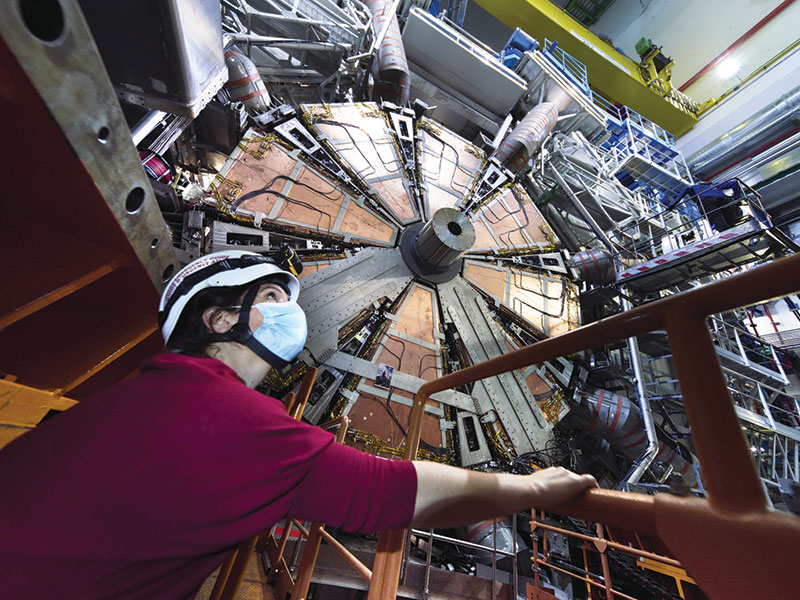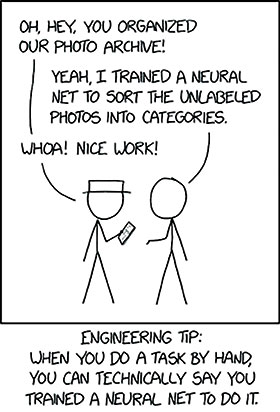A Physicist’s Guide to Machine Learning and Its Opportunities
Spring
2022
Feature
A Physicist’s Guide to Machine Learning and Its Opportunities
Kendra Redmond, Editor
 As we browse, drive, watch, and order, data pours into the ether. Our behaviors and preferences are collected and analyzed, and in response, the world changes. The combination of advances in semiconductor computation devices and this new and extremely large influx of data has powered rapid growth in machine learning.
As we browse, drive, watch, and order, data pours into the ether. Our behaviors and preferences are collected and analyzed, and in response, the world changes. The combination of advances in semiconductor computation devices and this new and extremely large influx of data has powered rapid growth in machine learning.
 “The world is becoming more digitized, whether or not we want it,” says Evgeni Gousev, a PhD physicist and senior director at Qualcomm Technologies Inc., a company working toward an internet-of-things reality where billions of devices are intelligently connected. “We are all living in a data-driven world now,” he says.
“The world is becoming more digitized, whether or not we want it,” says Evgeni Gousev, a PhD physicist and senior director at Qualcomm Technologies Inc., a company working toward an internet-of-things reality where billions of devices are intelligently connected. “We are all living in a data-driven world now,” he says.
Companies like Facebook (now Meta) are paying unfathomable sums of money to acquire technology startups, often for access to their data. And it’s not just tech companies buying tech startups. The pharmaceutical company Pfizer gave Israel COVID-19 vaccine priority in 2021, in part because Israel agreed to share health data on its citizens. “Data is an integral component of the digital economy,” says Sandeep Giri, a staff project manager at Google and honorary member of Sigma Pi Sigma.
With data―and the ability to interpret it―comes power. That may include economic power and the power to influence public opinion, but it can also include the power to improve access to education and healthcare, the diagnosis and treatment of diseases, car crash survival rates, severe weather predictions, our understanding of the universe, and many other aspects of the human experience.
Finding meaning in massive amounts of messy, real-world data is a challenge, but it’s one that physicists are uniquely poised to tackle. We’re in the midst of “a once-in-a-century opportunity for physicists to play a bigger role in society,” says Gousev.
Machine learning
That opportunity lies in the rapidly growing field of machine learning. A subset of artificial intelligence (AI), machine learning is perhaps the most powerful tool we have for making sense of data that isn’t neatly organized or for which we don’t know all the governing rules. Machine learning describes a system in which an algorithm, or set of algorithms, learns from data and adapts. It’s a salient correlation to the process of applying physics to the real world.
“Machine learning is essentially a system in which rather than building an algorithm or a model from an explicit description of desired behavior, we provide a set of examples that define the desired behavior of the system,” says Chris Rowen, vice president for engineering for Collaboration AI at Cisco.
Rowen gives this example: Say you want a program that classifies something as a dog or a cat. You probably don’t want to try to describe what makes a cat a cat or what makes a dog a dog, in algorithmic terms. Instead, machine learning allows you to train a generalized system with a bunch of pictures of cats and dogs. From these inputs, the system extracts the relevant features of dogs and cats and infers an algorithm that distinguishes between these two classes of inputs across a wide variety of kinds of pictures.1
“Machine learning is really great for cases where you don’t have an algorithm with explicit rules on how to accomplish a certain task,” says Michelle Kuchera, a computational physicist and assistant physics professor at Davidson College. She says that it’s also great for discovery―looking for patterns, outliers, or unexpected behavior in data—and for making fast theoretical predictions. In cases when a prediction would typically take an extremely long time to calculate, you can use machine learning to build a surrogate model that can make much faster calculations.

From toolbox to sandbox
Machine learning has direct applications in physics and astronomy research. As co-PI of the Algorithms for Learning in Physics Applications group at Davidson, Kuchera collaborates with theoretical and experimental physicists to address computational challenges. Machine learning is ideal for overcoming some of these challenges, such as identifying interesting particle interactions among the huge data sets produced at particle accelerators and speeding up time-consuming theoretical predictions.
“If you look at the Large Hadron Collider (LHC), or any of the scientific instruments where there’s a lot of fine-tuning that’s all happening in real time with the magnets and so forth, and if you want to control them, it’s great to be able to do that using machine learning. . .You’re going to infer very complex patterns much more easily,” says Vijay Janapa Reddi, associate professor of engineering and applied science at Harvard University.
It’s not just the big particle physics collaborations that use machine learning. Scientists are using it to design new materials, find turbulent motion on the sun, uncover anomalies in the US power grid, give robots humanlike sensitivity to touch, and much more.
Machine learning isn’t a magic bullet for all situations. “If you have a really solid understanding of the physics and the explicit mathematical rules to accomplish a task that you’re interested in, then that’s the preferred method, unless there’s some challenge with implementing it or it’s taking too long to be reasonable,” Kuchera says. But it’s one more powerful tool in the data analysis toolbox.
Applying machine learning to areas outside of physics and astronomy also constitutes a gratifying and fulfilling career for many physicists and astronomers.
For his PhD thesis, Sean Grullon studied neutrino fluxes at the IceCube particle detector at the South Pole. He dabbled with machine learning at times, as one of many data analysis techniques. When he graduated and decided to leave academia, machine learning was starting to take off. Grullon jumped in and has been applying machine learning to healthcare-related challenges ever since. He’s now the lead AI scientist at Proscia, a startup that builds tools to help pathologists find better ways to fight cancer. They’re using deep learning, a subset of machine learning that utilizes neural networks, to analyze pathology images for melanoma. Deep learning is particularly powerful for natural language processing and computer vision applications, which are notoriously difficult to do with conventional approaches.
“A physics background is really appropriate for the field of deep learning,” Grullon says, in part because of the math background physics requires―most machine learning algorithms reflect different applications of linear algebra—and in part because physicists understand data. Compared to what you might find in a computer science class, data from the real world is messy. But physicists are comfortable with error bars, uncertainties, and probabilities. Grullon has found his career path to be gratifying. “I’ve found it rewarding, very interesting, and also very impactful,” he says.
Machine learning is “a wonderful, wide-open area,” says Helen Jackson, a PhD nuclear physicist and machine learning researcher. Jackson’s PhD thesis focused on the effects of radiation on high-electron-mobility transistors. Upon graduation she had lots of data analysis and software experience, and while looking for a job, she taught herself machine learning. That opened the door to a position applying deep learning to airport security―using computer vision to detect threats in the cluttered airport environment. Since then she’s worked as a contractor on machine learning applications ranging from position-sensitive detection in computer vision to complex document understanding.
In Jackson’s opinion, physicists are primed to work in machine learning. She has found that some companies “actually prefer to hire someone like a physicist or chemist rather than a straight computer science major, because a computer science major knows the mechanics of the code, but we know the underlying application and what this machine learning [system] is supposed to do.” She says the work is a lot of fun, and the applications are “just fascinating.”
At Cisco, Rowen leads the team charged with improving the audio and video environment of the WebEx collaborative platform with machine learning and AI. With a bachelor’s degree in physics and a PhD in electrical engineering, he finds the mixture of important societal questions, computer architecture, and fundamental physics in machine learning fascinating.
Machine learning deals with computationally hard problems, like what makes up speech, but uses physical systems that you can trace all the way down to electrons, Rowen says. “This continuity of understanding from physics on up through the computer architecture questions, the computationally hard algorithm questions, and the application questions surrounding machine learning and neural networks has been so exciting and interesting,” he says.
Opportunities for physicists
 Gousev earned his PhD in solid state physics and has spent most of his career at IBM and Qualcomm developing new technologies, many involving machine learning. As the AI-based economy comes racing toward us, he sees not just an opportunity but a need for physicists to get involved. “We look at the whole world around us through a different type of lens, through a different type of mindset. We look at connecting dots in the environment, because we’ve been trained to look at the laws of physics and understand how things are connected in the world,” he says.
Gousev earned his PhD in solid state physics and has spent most of his career at IBM and Qualcomm developing new technologies, many involving machine learning. As the AI-based economy comes racing toward us, he sees not just an opportunity but a need for physicists to get involved. “We look at the whole world around us through a different type of lens, through a different type of mindset. We look at connecting dots in the environment, because we’ve been trained to look at the laws of physics and understand how things are connected in the world,” he says.
That holistic picture of machine learning ranges from electrical components to program architecture and even ethics. What is the problem? What are possible solutions? Should we even be solving this problem? Who else might utilize this solution? What biases and inequities might emerge if this method is used with other data sets, like data on humans?
Sorting through these questions requires a well-equipped, critically thinking, and creative workforce. “We have to prepare students for this new economy, and I strongly believe physics departments have a big opportunity,” Giri says. But taking advantage of that opportunity will require some changes. “There is a disconnect between physics departments and the AI-based economy that is inevitably coming our way,” he says.
After earning bachelor’s degrees in physics and mathematics, Giri was on his way to a PhD in materials science and engineering when he decided to change course and take a job in industry. He’s worked at Qualcomm and then for Google on projects ranging from head-mounted displays to supercomputers. He’s also been an advisor for undergraduate physics education efforts through the American Institute of Physics (the parent organization of Sigma Pi Sigma) and the American Physical Society, and is a board member of the AIP Foundation.
Giri says that the tools exist to prepare physics and astronomy students for this new paradigm, but physics departments need to embrace them. Physics departments often leave students feeling intimidated by and unprepared for careers in industry, whether by lack of knowledge or in favor of promoting a more traditional academic degree path. Many young students think the only physics career path is academia, and some choose not to major in physics for this reason.
“I believe that a majority of physics majors today don’t only want to learn Newton’s laws or the Schrödinger equation. They want to know ‘What type of skills do I need to solve the problems that bring meaning to me? How can I build a product or service that leaves an impact on the world?’” Giri says.
“Physics students would benefit from an awareness of all the technical and nontechnical career paths that exist in the machine learning and AI space,” says Giri. That ranges from software engineering to hardware design, systems engineering, supply chain, operations, product and project management, sales and business development, and beyond. These are all careers that people with a physics background can and do grow into.
Machine learning is at the intersection of skills, opportunity, and change-the-world capacity, and that’s a huge opportunity for physics and astronomy departments to attract and retain new students―including students from groups that are traditionally underrepresented in physics. For example, in 2020 the TEAM-UP report noted the following key findings during its study of systemic issues that contribute to the underrepresentation of African Americans in physics and astronomy:2
The connection of physics to activities that improve society or benefit one’s community is especially important to African American students.
Having multiple pathways into and through the major helps to recruit and retain students who may not have initially considered physics or astronomy as an option.
There is a vast set of existing resources that departments, physics students, and professional physicists can utilize to take advantage of machine learning and its opportunities. Many are free or low cost and don’t require anything but curiosity, a willingness to learn and explore, some logical thinking, and a bit of math―all things every physicist and astronomer has in good measure.
Notes
1. To read more about classification algorithms in machine learning, see Sidath Asiri, “Machine Learning Classifiers,” Towards Data Science (blog), June 11, 2018, towardsdatascience.com/machine-learning-classifiers-a5cc4e1b0623.
2. The TEAM-UP report was written by the AIP National Task Force to Elevate African American Representation in Undergraduate Physics & Astronomy (TEAM-UP) in 2020. It’s the result of a two-year investigation into the long-term systemic issues within physics and astronomy that have contributed to the underrepresentation of African Americans in these fields and includes actionable recommendations for reversing the trend. See TEAM-UP Task Force, The Time Is Now: Systemic Changes to Increase African Americans with Bachelor’s Degrees in Physics and Astronomy (American Institute of Physics, 2020), www.aip.org/diversity-initiatives/team-up-task-force.
Spotlight on TinyML
In its early days, machine learning was done at large-scale data centers, but now the technology has moved into our phones and homes—think Alexa and Siri. There’s so much data that it’s not cost-effective, energy efficient, or at times even practical to move all of this data into the cloud for processing. In the cutting-edge research area of TinyML (tiny machine learning), scientists are running machine learning models on ultra-low-power microcontrollers. They aim to keep the data processing as close as possible to the data, thereby enabling always-on sensors or other devices, more secure networks, and the ability to add features like voice recognition to small devices that can’t be recharged frequently. Learn more at www.tinyML.org.
Get Up to Speed on Machine Learning
There are many widely available, internet-based resources on machine learning. This list is compiled from recommendations given by the physicists interviewed for A Physicists Guide to Machine Learning and Its Opportunities. In most cases URLs are not listed, but if you’re interested in machine learning you won’t have any trouble finding them.
Learning Python
- Machine learning is commonly done using Python. Google’s Python Class and Microsoft’s Introduction to Python are good, free online classes.
Blogs and background
- To get a sense of machine learning, its vocabulary, and what’s happening in the field, check out blogs like Google AI, Facebook AI, Berkeley AI Research, and Stanford AI Lab. If what they’re writing about excites you, that’s a good indication you should investigate it further.
- Towards Data Science is another great blog if you’re just getting started. They have a lot of introductory articles that explain machine learning and deep learning algorithms and how to get started.
Setting up your system
- Scikit has a package for Python for machine learning with a good overview of machine learning algorithms and how to incorporate them in Python.
- Environments like TensorFlow (Google) and PyTorch (Facebook) allow you to quickly build models for whatever kind of data you have.
Online courses
- Platforms like edX, Coursera, Udemy, and Udacity have free or low-cost Python classes and machine learning classes with projects that you can complete and show a prospective employer. Andrew Ng’s machine learning course out of Stanford is very popular, and it’s free on Coursera.
- HarvardX’s Tiny Machine Learning (TinyML) and Google are collaborating on a series of courses focused on TinyML. The courses cover topics from the fundamentals of machine learning to collecting data, designing and optimizing machine learning models, and assessing their outputs. The first three courses are available now on edX, https://tinyml.seas.harvard.edu/courses/.
- The Google Cloud AI Platform has tools, videos, and documentation for data science and machine learning, https://developers.google.com/learn/topics/datascience. The following resources may be especially helpful:
- Google’s codelab “TensorFlow, Keras and deep learning, without a PhD”
- Online learning channel, www.youtube.com/user/googlecloudplatform
- Product documentation, https://cloud.google.com/docs - fast.ai has courses, tools, and articles for people interested in getting into machine learning.
Getting data
- Don’t have data? There are public domain data repositories with data on almost anything you could want, and most machine learning courses will direct you to them. Kaggle has lots of public datasets.
Resources for teaching
- In support of departments that want to teach their students about machine learning, Harvard has made much of its TinyML content and classroom materials, open source licensed and available at https://tinyml.seas.harvard.edu/#courses.
